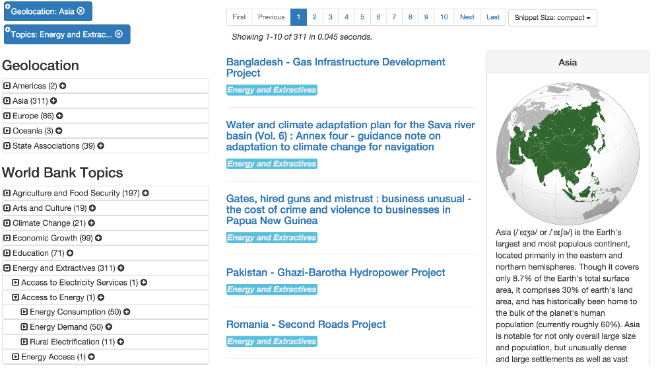Consistency is crucial to a good user experience. Designers go to great lengths to create and test consistent visual designs. The organization of information is of equal importance to a good user experience, but it is often overlooked in the design process. A well organized site improves findability so that people can quickly search or browse to find the information they are looking for. Taxonomies are used to create, standardize, and centralize the structure of a site. Here are a few examples of how taxonomies created in PoolParty (www.poolparty.biz) can be used to drive user experience.
Faceted Navigation
Faceted navigation uses categories to help users navigate the site and narrow their search. When users seek to find content, they iteratively modify their search queries based on information presented in the search results. Faceted navigation takes advantage of this behavior and allows users to simultaneously search and browse while narrowing the amount of content they interact with. This reduces the number of queries a user must enter and gives users better insight into the structure and semantic categories used on the site or intranet. When this search functionality is implemented in an intranet or website, it brings a common and positive user experience while increasing findability. PoolParty can be used to create faceted navigation like the one below:
Online demo: http://marklogic-demo.poolparty.biz/
Semantic Links
When we expand the hierarchical relationships found in a taxonomy to support associative and equivalence relationships, we create a thesaurus. Thesauri allow us to take advantage of the benefits provided by a taxonomy while managing synonyms and associative relationships. Thesauri help guide users to one term regardless of what terms they use to search. This makes search results more accurate. Connecting synonyms, near-synonyms, acronyms, abbreviations, lexical variants, common misspellings, and related terms to one preferred term allows us to create rich semantic links and minimize semantic ambiguity. If the information environment is multilingual, equivalent terms in other languages can be displayed. Semantic links of search terms can be displayed in addition to the actual search results. Consequently, the user receives not only documents but also contextual information around a topic of interest. The example below shows how additional information around ‘photovoltaic’ helps to navigate to related topics like ‘solar cells’ or ‘solar thermal’.
Infobox contextualizes a search term and provides semantic links
Landing or topic pages
 Taxonomies help publishers to maintain and create landing or topic pages dynamically. For example, a taxonomy as illustrated on the left, could aggregate all content assets annotated with any of the subconcepts (recursively) of ‘Psychotherapy’. This approach supports a more dynamic creation of menu items and decouples the semantics of an asset from its position in a navigation structure. The result is a search-driven customer journey rather than a static navigation structure that can be modified and extended at any time e.g. to support temporary campaigns. In this four-layered content architecture (see image below), navigation and menu structures are clearly separated from metadata, and from taxonomies that describe the semantics of metadata independently from the underlying content assets. As a result, menu points can be modelled as ‘containers’ of concepts derived from the taxonomy (e.g. with skos:Collection). This approach for a dynamic management of navigation structures is highly efficient, especially in multi-site environments. With the use of poly-hierarchies, multiple navigation paths can be created, which lead to the same content from various menus and sub-menus.
Taxonomies help publishers to maintain and create landing or topic pages dynamically. For example, a taxonomy as illustrated on the left, could aggregate all content assets annotated with any of the subconcepts (recursively) of ‘Psychotherapy’. This approach supports a more dynamic creation of menu items and decouples the semantics of an asset from its position in a navigation structure. The result is a search-driven customer journey rather than a static navigation structure that can be modified and extended at any time e.g. to support temporary campaigns. In this four-layered content architecture (see image below), navigation and menu structures are clearly separated from metadata, and from taxonomies that describe the semantics of metadata independently from the underlying content assets. As a result, menu points can be modelled as ‘containers’ of concepts derived from the taxonomy (e.g. with skos:Collection). This approach for a dynamic management of navigation structures is highly efficient, especially in multi-site environments. With the use of poly-hierarchies, multiple navigation paths can be created, which lead to the same content from various menus and sub-menus.
Four-layered content architecture
Personalization
The basic foundation to delivering a personalized customer experience is common semantics of user interests or skills and available contents or products. Controlled vocabularies, taxonomies, and domain ontologies help to link user interest or skill profiles to related content assets. Recommender Systems based on semantic knowledge graphs are more precise than other techniques like Vector Space Models: concept based approaches don’t use just the words being found in a text, but rather use the concepts behind the content assets to predict its semantic similarity to other objects. This makes it possible to find relations between entities that do not have anything in common at first glance, i.e. when taking a look at the words or phrases being used.
Conclusion
Consistency is the foundation of any positive user experience. When users can quickly understand an information environment they are more likely to enjoy using it and use it frequently. Taxonomies and thesauri allow us to categorize and centralize an information environment in a way that makes sense to the user. This creates a consistent mental model that users can easily understand. In short, taxonomies drive user experience. PoolParty (www.poolparty.biz) is one of our favorite tools for developing and managing effective taxonomies and thesauri that create positive user experiences across any information environment.
This blog was co-written by Andreas Blumauer of Semantic Web Company.
Andreas Blumauer (Semantic Web Company)
 Andreas is CEO of Semantic Web Company and Product Architect of PoolParty Semantic Suite. He has worked on semantic web technologies, products, and methodologies since 2001. He is passionate about providing added value to organizations by linking and contextualizing information in a meaningful way based on semantic web standards.
Andreas is CEO of Semantic Web Company and Product Architect of PoolParty Semantic Suite. He has worked on semantic web technologies, products, and methodologies since 2001. He is passionate about providing added value to organizations by linking and contextualizing information in a meaningful way based on semantic web standards.
https://www.linkedin.com/in/andreasblumauer




